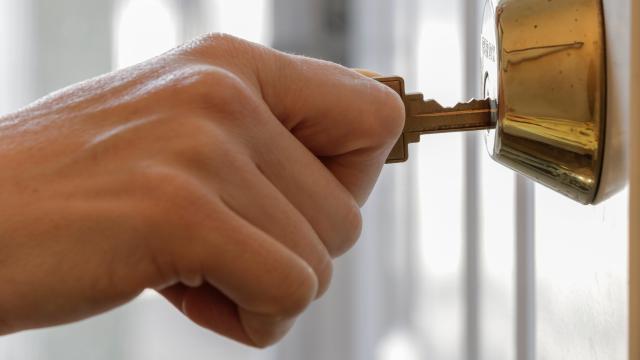Getting your door locks to work like they should isn’t just a matter of convenience, but of safety as well — taking the hassle out of dealing with your door locks will make you more likely to practice good locking habits. But sometimes your locks can become uncooperative, requiring you to set down your bag of groceries down to fiddle with the mechanism for a few minutes before your key will actually work. If this sounds familiar, here are some ways you to address sticky locks and latches so that your keys turn easily — without calling in a pricey professional locksmith.
Prevent unnecessary wear and tear
To prevent problems with your locks, avoid slamming your doors, putting stress on your knobs and handles, and putting excess weight on the door itself. Pulling the hinges out from the casing or snapping the hardware against itself will wear out lock parts faster, and sometimes these problems can be difficult to repair.
Clean your door lock
To address a sticky lock, the first step is to clean out the whole mechanism. Use canned air or a pressurised air tool for a compressor to blow any debris clear of the key hole. Sometimes dust or particles of dirt can make their way into the lock mechanism, causing the key to not fit quite right, and this will help with that problem, too.
The next thing to clean is the latch and deadbolt. Turn all the handles and locks while the door is open and wipe down any exposed parts on the edge of the door. You can do the same with the strike plate–the metal plate that receives the latch and deadbolt on the frame side of the door — as if anything sticky gets in there, it can also jam things up.
Use lubricant
Once everything is clean, the next step is to lubricate the lock. The two most common types of lubricant for locks are teflon and graphite, which are both dry lubricants. Products like WD-40 and other greasy lubricants can catch particles and stick them to the inside of your lock, actually making the problem worse, so most professionals recommend against using them.
Apply the lube to the lock by placing some into the keyway and working it in by inserting the key and turning the lock a few times. This process should only need to be done about once a year. If you’re finding that you have recurring issues with your lock, chances are there’s a different problem causing them.
Align your strike plate
If your door lock and your strike plate aren’t lined up properly, it can cause the lock to stick, as the weight of the door may be partially resting on the edge of the strike plate instead of the hinges. Check out the hinges to make sure they’re not loose and make sure that the weather stripping isn’t pushing the door out of alignment with the frame. If you have to move the door up or down to get it to latch properly, or if turning the handle is difficult when opening or closing the door, chances are that you have an alignment issue. If the strike plate is slightly too high or too low, you can fix it yourself by unscrewing it, drilling new holes, and screwing it back in in the right spot (you may also have to enlarge the opening in your door frame to allow the latch somewhere to go).. Some strike plates have built-in slots that allow them to be moved slightly up or down without completely unscrewing them. If that’s the case, you can just loosen the screws, move the strike plate to the desired position, and tighten everything back up.
Use only your original keys to make duplicates
If you have taken all these steps and are still left with sticky locks, your keys might be at fault, especially if your copy was made from a copy of a copy. If you still have the original keys, using them to make copies is the best way to go. The farther from the original you get, the more deformed the mould can become. If your problems are persistent and without any other obvious cause, this could be the source of your woes.
If all else fails, call a professional
Unfortunately, if you don’t have the original keys for your lock, the way to address it is likely to replace your locks, or rekey them. For that, you likely will need the services of a professional. You might also want to call in a pro if you have recurring issues that aren’t fixable by normal maintenance and addressing wear and tear. There could be another problem with your door or door casing that requires someone with experience to diagnose. While an adventurous DYI-er could potentially tackle these problems, they will likely take more than a screwdriver and some patience.

Leave a Reply
You must be logged in to post a comment.